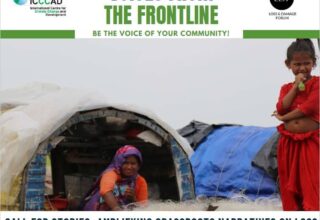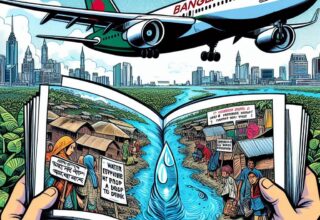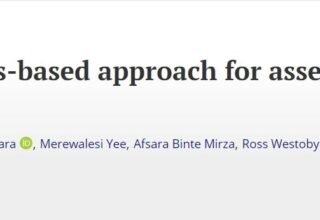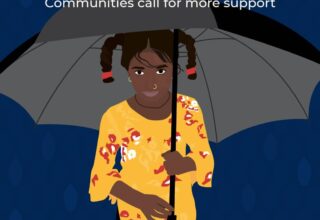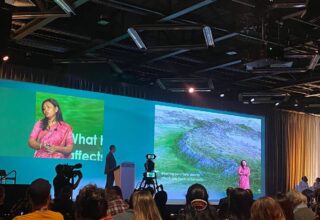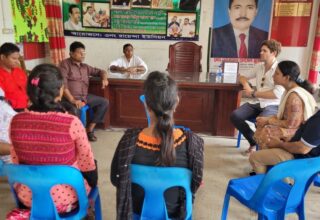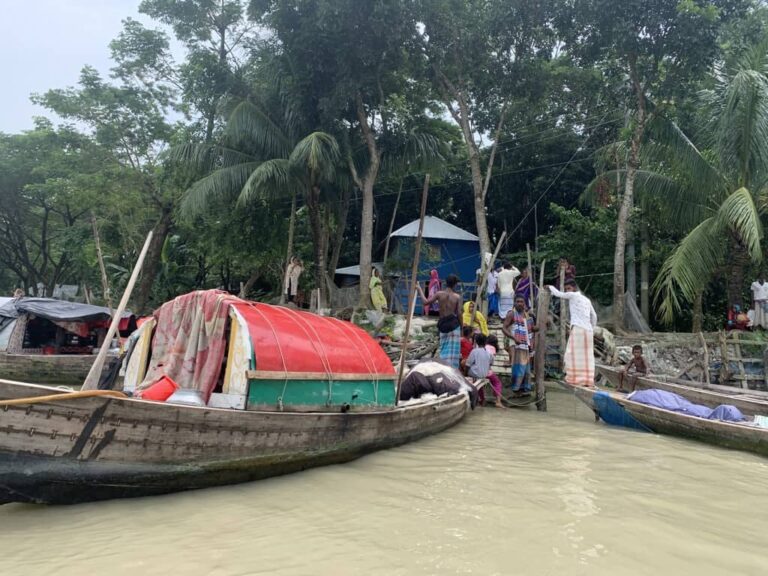
“We are born on this boat [and] we live on the boat. This is our home … without our boat wewould have no means to eat. If we did not have our boats, we would just die.[i]– Member of the Manta Community“
The impacts of climate change have internally displaced more than 30 million people worldwide in 2022 alone.[i] Climate hazards, triggered by more intense and frequent extreme weather events, including cyclones, droughts or heavy rainfall and slow onset events, such as sea-level rise, devastate lives and livelihoods and prevent those already displaced within their countries from returning. While the world is on track for at least 3°C global warming, unless current greenhouse gas emissions are rapidly reduced, the risk of more climate hazards will significantly grow.[ii] This will further increase people’s vulnerability to loss and damage (L&D) and the risk of displacements, as adaptation limits are reached.[iii] Thus, to avert, minimize and address L&D and for people to rebuild their lives and livelihoods after displacement, support on L&D needs to include displacement.
Displacement as L&D
While there is no official definition, L&D has been consistently associated with the risks and adverse impacts of climate change resulting from both extreme weather events and slow-onset events.[iv] In general, “damages” are associated with impacts that can be alleviated or repaired, such as damage of houses or crops, by contrast “losses” are irreversible and include, for example, the loss of human life or biodiversity.[v] A further distinction is made between economic losses and damages, such as goods and services, and non-economic losses and damages (NELD) which include the loss of life, cultural heritage, local knowledge or ecosystems service.[vi] While displacement is a form of loss and damage which perpetuates vulnerability, it is also a form of NELD itself.[vii] Forcing people to leave their homes and communities, displacement adversely affects people’s well-being, identity and fundamental human rights.[viii]
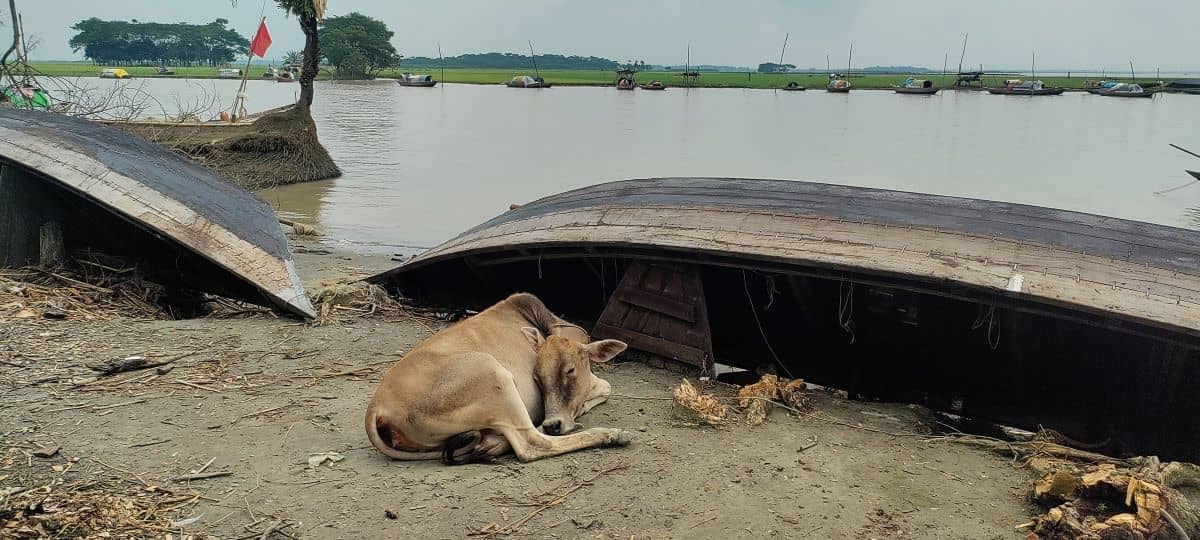
L&D and displacement in Bangladesh
As seventh most vulnerable country to climate change in the world, Bangladesh contributes just 0.4 per cent to global GHG emissions.[ix] While the country is recognized for its global leadership in disaster preparedness and climate change adaptation, severe climate risks and impacts due to slow onset and extreme weather events, such as floods, cyclones and sea level rise, have increased the vulnerability of people and ecosystems.[x] In a recent report, the World Bank predicted that in the next 30 years, 13.3 million people in Bangladesh may become internally displaced as a result of climate impacts on water scarcity, agriculture and rising sea level.[xi] In 2022, floods, the worst in a century, affected 7.28 million people and forced more than 2 million to leave their homes and migrate to other areas.[xii] Floods particularly affect coastal residents and riverside communities owing to their direct exposure and limited capacity to adapt.[xiii] In addition, floods and heavy rainfall drive riverbank erosion which cause losses and damages to houses and agricultural lands, impacting on average the lives of 200,000 people every year.[xiv] The Center for Environmental and Geographic Information (CEGIS) estimates that almost 160,000 hectares of land were lost to riverbank erosion along the Jamuna, Ganges and Padma rivers between 1973 and 2021.[xv] The loss of land forces thousands of people every year to migrate to towns and cities to live in urban slums without or inadequate external support.[xvi]
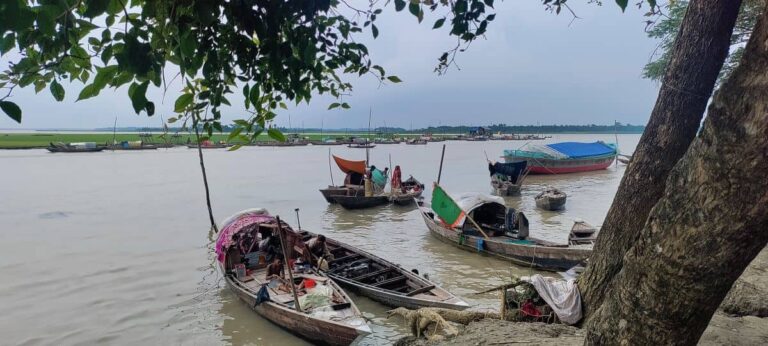
Manta Community
The Manta, a long-enduring floating fishing community situated in the south-west coastal region, is among the country’s oldest fishing communities. Their traditional livelihood revolves around fishing, boats, and rivers, aligning seamlessly with the Bengali people’s fondness for fish as it constitutes their sole source of income. Each family possesses a boat, with these vessels forming integral parts of their lives, intricately connecting them to the surrounding water. For countless years, the Manta community has navigated the waters of this region, rich in numerous rivers and their tributaries, sustaining their fishing activities until recent times.
Since they lost their lands to riverbank erosion decades ago, however, the Manta, counting today about 300,000 people, have been forced to live on their boats.[xvii] Without shelter, life on the river makes them highly vulnerable to extreme weather events, such as heavy rains or cyclones. Because they do not have a permanent address, they do not qualify for state support, including national social safety net programmes. They entirely rely on fishing to survive which is increasingly threatened by overfishing owing to a growing population and commercial fishing.[xviii]
“The river keeps us alive. I pick up the net I throw into [the water] with high hopes every time. If I manage to catch fish, I can buy daily essentials. We can eat and feed the children. Debt increases if I don’t fish,” said a fisherman, member of the Manta community in Laharhaat, Barishal.[xix]
Furthermore, obtaining healthcare has consistently posed difficulties for the community, due to their absence of a stable home. The Manta’s constant exposure to sun, water and harsh weather causes them to frequently suffer from health issues, such as skin diseases. In serious cases, access to health care is often hampered by far-off hospitals and expensive medical fees. In the past, the head of the family and the community leader have reached out to someone on the land for initial assistance, before transferring the sick to the nearest hospital or clinic. However, with limited wealth, which the Manta women wear in form of minimal gold nose pins or bangles, obtaining healthcare remains in many cases challenging. Even in the event of death, the Manta require the permission of land owners to bury their dead.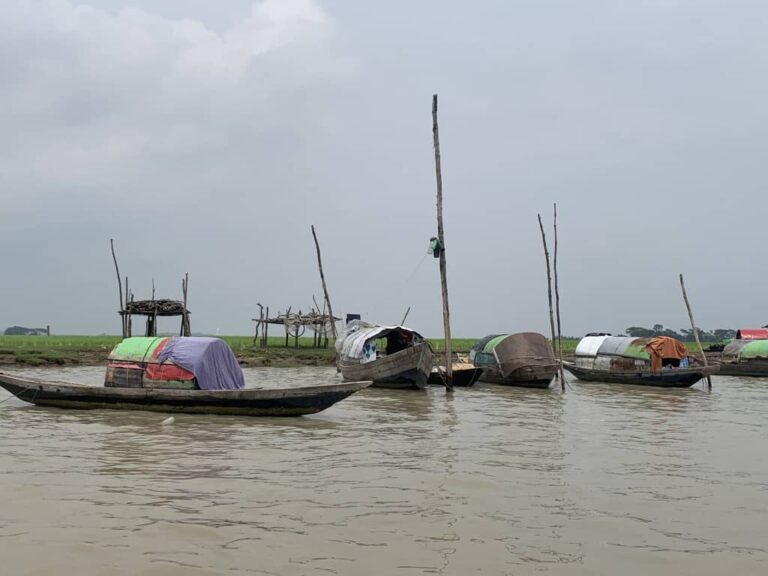
A woman from the community said, “Every time, a storm brews, we have to move towards smaller streams, to not be upturned by storm surges. Getting frequently drenched causes illness to most of us, with no available health facilities for our tribe”.
Many Manta wish a different life for their children and want them to be educated. But education is expensive or inaccessible and thus, the low school attendance of children in the community is a significant concern. Further, there have been cases of Manta children being bullied by children living in nearby villages, for example, by calling them “upraitta,” which means uncivilized, and other degrading names. Many children abandon education before completing primary school, opting instead to stay on boats with their parents, learning fishing from a young age. With fishing becoming less profitable and riskier, potential loss of traditional ways of life and cultural practices looms large if the younger Manta community members shift their professions.
“We are denied our basic rights, such as food, shelter, education – and it’s continuing from generation to generation. We are in the shadows of civilisation,” says, a Manta leader.[i]
As displaced persons without access to assistance, resources, effective remedies and justice,[ii] the Manta are among the most vulnerable communities to the adverse effects of climate change in Bangladesh. Displacement often exacerbates inequalities and the vulnerability that marginalized groups or individuals are already exposed to.[iii] Further, the impact of NELD, such as psychological impacts, deterioration of safety or access to health care, are experienced differently, with women, children, the elderly and disabled people being usually the most affected because of pre-existing vulnerabilities.[iv] For example, as fishing has become more challenging in the intense heat and sunlight, women have expressed their worry about skin burns from the prolonged exposure to the sun. Skin burns have impacted their self-esteem as they feel that they no longer look good. As a result, this has further added to the increase in child marriage in the community, a practise which is already driven up by economic vulnerability, even though the legal age for women to get married is 18 under the Child Marriage Restraint Act 2017.
Manta community leaders have been trying to reach out to local governmental organizations, non-governmental organizations and local elites for support. The Manta want to live on land and some hope to switch their profession as catching fish is more dangerous now and most of the time not profitable. To avoid increasing debt burden, many fishermen opt for going to deeper water to fish risking lives and livelihoods of their entire families.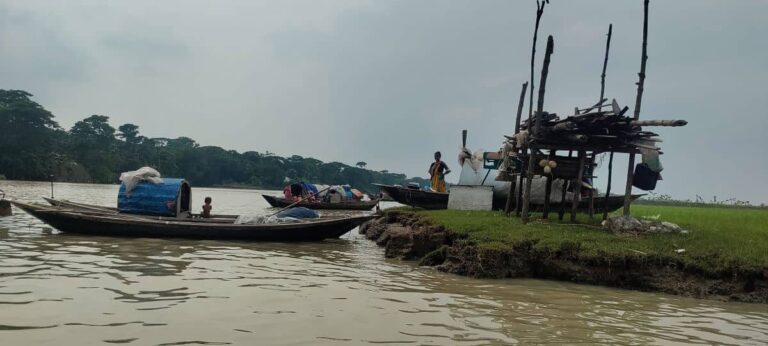
Under the Ashrayan project, a nationwide governmental initiative to rehabilitate the landless, homeless and poor providing them with semi-furnished houses and land ownership, a community of 29 Manta families were relocated in Rangabali, Patuakhali district last year.[i] However, some have rejected such offers voicing their concerns over houses being located too far from their fishing grounds cutting them off from their livelihoods.[ii] Thus, to be sustainable and effective, initiatives tackling L&D and NELD should centre around the voices and needs of those at risk and align with what displaced people prioritize and value the most.[iii]
In this respect, Bangladesh’s National Strategy on Internal Displacement Management of 2021, one of the first frameworks developed by a member of the Climate Vulnerable Forum, aims to make vulnerable communities resilient to climate change and disasters.[iv] Developed through a bottom-up community-based consultative process, the Strategy and its Action Plan (2022-2042) focus on prevention of displacement, protection during displacement and durable solutions through measures tailored to the particular needs of the displaced and communities at risk.
Conclusion
With the increase in emissions and climate hazards resulting in more losses and damages including displacement within and across national borders, the window of opportunity to secure a liveable future is already closing for millions of people around the world. The costs of L&D, not including NELD, are estimated to account for at least 290 to 580 billion USD worldwide by 2030.[vi] Further, this does not include the cost of planned relocation which will be increasingly required in support of vulnerable people unable to move on their own amid intensifying climate risks.[vii]
Averting, minimizing and addressing the different forms of climate-induced losses and damages requires to close the gaps in the knowledge and understanding of the occurrence and impacts of climate-related displacement.[viii] Thus, more assessment through data collection is needed, especially that not all forms of L&D and NELD are homogenous and impacts are experienced differently across contexts, communities and groups.[ix] Moreover, an assessment of all forms of loss and damage is important to make them relevant for the discussions surrounding the set-up of the L&D Fund and to inform tailored financial and technical support mechanisms to assist vulnerable countries in the prevention and response to displacement in the future.[x] Thus, every step of the way of addressing climate change induced losses and damages requires locally led practices as they are the first responders to any kind of impacts and they are the ones who know how it has to be addressed.
Authors:
Charlotte Kaeppel is an independent consultant and a visiting researcher at ICCCAD.
Nusrat Naushin is working in ICCCAD as a Research Officer and Co-coordinator of the Loss & Damage Programme.
[i] “Floating ‘Manta’ community gets home in Patuakhali,” Daily Observer, April 6, 2022, https://www.observerbd.com/news.php?id=360516 .
[ii] Zakir Hossain Chowdhury, “Without Land, Bangladesh’s Manta People lLve – and Die – on Boats,” Thomson Reuters Foundation, July 12, 2022, https://www.context.news/climate-risks/without-land-bangladeshs-manta-people-live-and-die-on-boats?utm_source=news-trust&utm_medium=redirect&utm_campaign=context&utm_content=article.
[iii] Loss and Damage Collaboration (L&DC) and Researching Internal Displacement (RID), “Loss and Damage and Dispacement: Key messages for the road to COP28”, September 19, 2023, 4, https://www.lossanddamagecollaboration.org/stories/loss-and-damage-and-displacement-key-messages-for-the-road-to-cop-28.
[iv] Tasneem Siddiqui, Md. Ekhtekharul Islam and Tamim Billah, “Policy architecture to address disaster and climate change induced displacement in Bangladesh,” Researching Internal Displacement, March 9, 2023, https://researchinginternaldisplacement.org/short_pieces/policy-architecture-to-address-disaster-and-climate-change-induced-displacement-in-bangladesh/.
[v] Ministry of Disaster Management and Relief, “National strategy on internal displacement management,” Government of Bangladesh, January 2021, https://modmr.portal.gov.bd/sites/default/files/files/modmr.portal.gov.bd/publications/d05820e8_b72f_43a1_8cfe_4b4bd34a2560/NSIDM%20Publication(Size%206.5%20X%209.5%20in).pdf.
[vi] “What is loss and damage?” The Loss & Damage Collaboration, accessed October 6, 2023, https://www.lossanddamagecollaboration.org/whatislossanddamage.
[vii] IPCC, Climate Change 2022: Impacts, Adaptation, and Vulnerability, Contribution of Working Group II to the Sixth Assessment Report of the Intergovernmental Panel on Climate Change (New York: Cambridge University Press, 2022), 65, doi:10.1017/9781009325844.
[viii] Internal Displacement Monitoring Centre (iDMC), Platform on Disaster Displacement (PDD), and International Organization for Migration (IOM), 15 Observations on Disaster Displacement as Loss and Damage, (iDMC, PDD, and IOM, 2022), 1, https://disasterdisplacement.org/portfolio-item/15-observations-on-disaster-displacement-as-loss-and-damage/.
[ix] Alice Baillat, “Seizing the opportunity to address disaster displacement in the loss & damage discussion,” Internal Displacement Monitoring Centre, June 2023, https://www.internal-displacement.org/expert-opinion/seizing-the-opportunity-to-address-disaster-displacement-in-the-loss-damage.
[x] Internal Displacement Monitoring Centre (iDMC), Platform on Disaster Displacement (PDD), and International Organization for Migration (IOM), 15 Observations on Disaster Displacement as Loss and Damage, (iDMC, PDD, and IOM, 2022), https://disasterdisplacement.org/portfolio-item/15-observations-on-disaster-displacement-as-loss-and-damage/.
[i] Zakir Hossain Chowdhury, “Without Land, Bangladesh’s Manta People lLve – and Die – on Boats,” Thomson Reuters Foundation, July 12, 2022, https://www.context.news/climate-risks/without-land-bangladeshs-manta-people-live-and-die-on-boats?utm_source=news-trust&utm_medium=redirect&utm_campaign=context&utm_content=article.
[ii] Deutsche Gesellschaft für Internationale Zusammenarbeit (GIZ) and et al., “Implementing the task force of displacement recommendations through loss and damage policy and practice: A contribution to loss and damage discussion from a human mobility perspective,” August 2023, 2, https://unfccc.int/documents/631161.
[iii] Deutsche Gesellschaft für Internationale Zusammenarbeit (GIZ) and et al., “Implementing the task force of displacement recommendations through loss and damage policy and practice: A contribution to loss and damage discussion from a human mobility perspective,” August 2023, 2, https://unfccc.int/documents/631161.
[iv] Alice Baillat, “Seizing the opportunity to address disaster displacement in the loss & damage discussion,” Internal Displacement Monitoring Centre, June 2023, https://www.internal-displacement.org/expert-opinion/seizing-the-opportunity-to-address-disaster-displacement-in-the-loss-damage.
[i] “I am a Manta,” 2 May 2019, https://www.youtube.com/watch?v=bTzyQnCqaPg.
[i] Internal Displacement Monitoring Centre (iDMC), Global Report on Internal Displacement (GRID) 2023: Internal Displacement and Food Security, (Geneva: iDMC, 2023), https://www.internal-displacement.org/global-report/grid2023/.
[ii] IPCC, “Summary for Policymakers, in Climate Change 2022: Impacts, Adaptation, and Vulnerability. Contribution of Working Group II to the Sixth Assessment Report of the Intergovernmental Panel on Climate Change, eds. H.-O. Pörtner, D.C. Roberts, M. Tignor, E.S. Poloczanska, K. Mintenbeck, A. Alegría, M. Craig, S. Langsdorf, S. Löschke, V. Möller, A. Okem, B. Rama (Cambridge: Cambridge University Press, 2022), 11, https://www.ipcc.ch/report/ar6/wg2/chapter/summary-for-policymakers/.
[iii] IPCC, “Summary for Policymakers, in Climate Change 2022: Impacts, Adaptation, and Vulnerability. Contribution of Working Group II to the Sixth Assessment Report of the Intergovernmental Panel on Climate Change, eds. H.-O. Pörtner, D.C. Roberts, M. Tignor, E.S. Poloczanska, K. Mintenbeck, A. Alegría, M. Craig, S. Langsdorf, S. Löschke, V. Möller, A. Okem, B. Rama (Cambridge: Cambridge University Press, 2022), 9, https://www.ipcc.ch/report/ar6/wg2/chapter/summary-for-policymakers/.
[iv] Paris Agreement to the United Nations Framework Convention on Climate Change, Dec. 12, 2015, T.I.A.S. No. 16-1104, art 8.
[v] Reinhard Mechler and et al., “Science for loss and damage: Findings and propositions,” in Loss and damage from climate change: Concepts, methods and policy options, eds. Reinhard Mechler and et al. (SpringerOpen, 2019), 11.
[vi] Erin Roberts and Sumaya Ahmed Zakieldeen, “Pocket guide to loss and damage”, European Capacity Building Initiative (ecbi), March 2018, 2, https://ecbi.org/sites/default/files/FinalVersionLoss%26Damage_0.pdf.
[vii] IPCC, “Summary for Policymakers, in Climate Change 2022: Impacts, Adaptation, and Vulnerability. Contribution of Working Group II to the Sixth Assessment Report of the Intergovernmental Panel on Climate Change, eds. H.-O. Pörtner, D.C. Roberts, M. Tignor, E.S. Poloczanska, K. Mintenbeck, A. Alegría, M. Craig, S. Langsdorf, S. Löschke, V. Möller, A. Okem, B. Rama (Cambridge: Cambridge University Press, 2022), 11, https://www.ipcc.ch/report/ar6/wg2/chapter/summary-for-policymakers/; Loss and Damage Collaboration (L&DC) and Researching Internal Displacement (RID), “Loss and Damage and Displacement: Key messages for the road to COP28”, September 19, 2023, 3, https://www.lossanddamagecollaboration.org/stories/loss-and-damage-and-displacement-key-messages-for-the-road-to-cop-28; Deutsche Gesellschaft für Internationale Zusammenarbeit(GIZ) and et al., “Implementing the task force of displacement recommendations through loss and damage policy and practice: A contribution to loss and damage discussion from a human mobility perspective,” August 2023, 2, https://unfccc.int/documents/631161.
[viii] Loss and Damage Collaboration (L&DC) and Researching Internal Displacement (RID), “Loss and Damage and Displacement: Key messages for the road to COP28”, September 19, 2023, 5, https://www.lossanddamagecollaboration.org/stories/loss-and-damage-and-displacement-key-messages-for-the-road-to-cop-28.
[ix] David Eckstein, Vera Künzel and Laura Schäfer, “Global Climate Risk Index 2021: Who Suffers Most from Extreme Weather Events? Weather-Related Loss Events in 2019 and 2000-2019,” Germanwatch, 2023, https://www.germanwatch.org/sites/default/files/Global%20Climate%20Risk%20Index%202021_2.pdf; World Bank, Bangladesh: Country Climate and Development Report (Washington: The World Bank Group, 2022), https://openknowledge.worldbank.org/server/api/core/bitstreams/6d66e133-e49d-5ad9-b056-7b1a6c6206ed/content.
[x] “Key Highlights: Country Climate and Development Report for Bangladesh,” World Bank, October 31, 2022, https://www.worldbank.org/en/news/feature/2022/10/31/key-highlights-country-climate-and-development-report-for-bangladesh#:~:text=At%20just%200.4%20percent%2C%20Bangladesh’s,GHG)%20emissions%20is%20not%20significant; United Nations Development Programme, Climate Vulnerability Index (CVI) (Dhaka: UNDP, 2023), https://www.undp.org/sites/g/files/zskgke326/files/2023-03/Climate%20Vulnerability%20Index%20Book.pdf .
[xi] “Key Highlights: Country Climate and Development Report for Bangladesh.”
[xii] Office of UN Resident Coordinator and Government of Bangladesh, Flood 2022 – Impact and Loss Summary, infographic, September 2, 2022, https://reliefweb.int/report/bangladesh/bangladesh-flood-2022-impact-and-loss-summary; Faisal Mahmud, “Bangladesh Floods: Experts Say Climate Crisis Worsening Situation,” Aljazeera, June 22, 2022, https://www.aljazeera.com/news/2022/6/22/bangladesh-floods-experts-say-climate-crisis-worsening-situation.
[xiii] Lucia Letsch, Shouro Dasgupta and Elizabeth JZ Robinson, “Tackling Flooding in Bangladesh in a Changing Climate,” Grantham Research Institute on Climate Change and the Environment, August 2023, https://www.lse.ac.uk/granthaminstitute/wp-content/uploads/2023/08/Tackling-flooding-in-Bangladesh-in-a-changing-climate.pdf.
[xiv]Jan Freihardt and Othmar Frey, “Assessing Riverbank Erosion in Bangladesh Using Time Series of Sentinel-1 Radar Imagery in the Google Earth Engine,” Natural Hazards and Earth System Sciences 23, no.2 (2023), https://nhess.copernicus.org/articles/23/751/2023/#:~:text=Around%2020%20out%20of%2064,land%20(Alam%2C%202017); DS Sourav, “Climate Change Causes Riverbank Erosion,” Bangladesh Post, August 29, 2019,
https://bangladeshpost.net/posts/climate-change-causes-riverbank-erosion-10536.
[xv] Ministry of Environment, Forest and Climate Change, National Adaptation Plan of Bangladesh (2023-2050), Government of the People’s Republic of Bangladesh, 2022, https://www4.unfccc.int/sites/SubmissionsStaging/Documents/202211020942—National%20Adaptation%20Plan%20of%20Bangladesh%20(2023-2050).pdf.
[xvi] Md. Rayhan Ali, Zihad Ahmed, AHM Hedayutul Islam, and Md. Mizanoor Rahman, “River Bank Erosion, Induced Population Migration and Adaptation Strategies in the Sirajganj Sadar Upazila, Bangladesh,” European Journal of Environment and Earth Sciences 2, no. 2 (2021): 40, https://www.ej-geo.org/index.php/ejgeo/article/view/131.
[xvii] Zakir Hossain Chowdhury, “Without Land, Bangladesh’s Manta People lLve – and Die – on Boats,” Thomson Reuters Foundation, July 12, 2022, https://www.context.news/climate-risks/without-land-bangladeshs-manta-people-live-and-die-on-boats?utm_source=news-trust&utm_medium=redirect&utm_campaign=context&utm_content=article.
[xviii] Zakir Hossain Chowdhury, “Without Land, Bangladesh’s Manta People lLve – and Die – on Boats,” Thomson Reuters Foundation, July 12, 2022, https://www.context.news/climate-risks/without-land-bangladeshs-manta-people-live-and-die-on-boats?utm_source=news-trust&utm_medium=redirect&utm_campaign=context&utm_content=article.
[xix] Rafiqul Islam Montu, “From birth to death: Bangladesh’s landless Manta community survives on boats,” Gaon Connection, July 30, 2020, https://en.gaonconnection.com/bangladeshs-manta-community-survives-on-boats-from-birth-to-death/.

